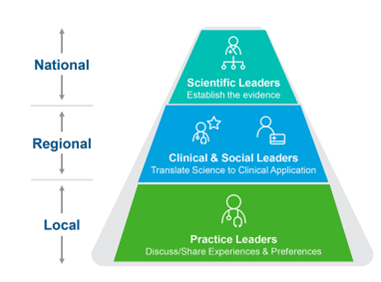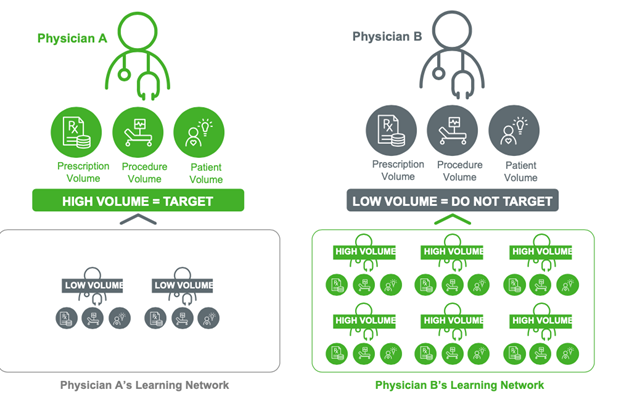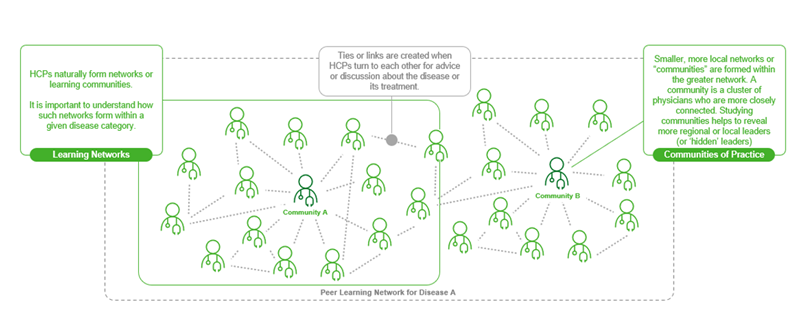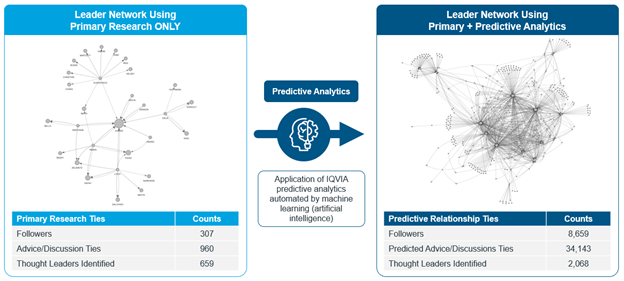Making the Invisible Visible: Revealing Thought Leader Networks with Predictive Analytics
Brand Insights - Thought Leadership | Paid Program

In the healthcare space, clinical thought leaders help educate their peers, generate new product awareness, establish credibility, and provide potential prescribers with rationale for treatment. In addition, selected thought leaders generate the clinical evidence that supports regulatory submission and defines clinical use of a new treatment. They’re a powerful asset for pharma medical affairs and commercial teams — but quite difficult to identify beyond the top prominent individuals who publish papers, speak at conferences, or serve as investigators for pivotal clinical trials. In addition, the most prominent thought leaders are often not the ones driving treatment behavior and product adoption at the regional and local levels of the general healthcare professional (HCP) population.
The industry has long sought to reveal the peer-to-peer relationship connections between healthcare providers and discover these “hidden” clinical thought leaders who provide guidance to their peers. But unfortunately, until now, these connections have been invisible due to limited available data and analytics capabilities.
We know relationships between HCPs are critically important. Providers look to many resources for continual learning to better care for their patients: journals, pharma companies, industry sales representatives, speakers, and especially their peers. Even though influential peers are difficult to identify, pharma has recognized the significance of their role for decades.
When these respected providers believe in a specific treatment, and communicate that preference to their professional networks, it informs other healthcare professionals’ treatment decisions, driving diffusion of innovation and adoption of new therapies during their critical first months in the market. In fact, IQVIA research has demonstrated that when a thought leader adopts a product, that leader’s connected HCP network adopts at a rate 25% higher than the networks of thought leaders who did not adopt.
And when doctors in a network adopt new therapies, a change in clinical thinking gets disseminated throughout the medical community, causing paradigm shifts in disease treatment and improvement in patient care and outcomes. That’s the power of thought leaders. And now, it’s more possible than ever to identify and engage the healthcare educators at all levels who play a role in this cascade of innovation.
Historically, the pharma industry has been able to identify national thought leaders (top of the pyramid in Fig. 1), but it has been nearly impossible to identify regional and local leaders who have smaller but still significant clinical spheres of influence. These physicians likely cannot be identified using traditional secondary research techniques as they may not publish nor partake in clinical trials. Their identification has been limited to opinions of field personnel or other equally subjective measures.
IQVIA research shows that a thought leader’s connected provider network adopts new products at a rate 25% higher than the networks of thought leaders who did not adopt.
When many doctors in a network adopt new therapies, new science gets disseminated throughout the medical community, causing a paradigm shift in the kinds of treatments patients receive.
Fig. 1

The size and potential of a thought leader’s network can’t be ignored. The industry has also long used volume data to value physicians as commercial targets, but arguably as important as a physician’s number of patients or prescriptions is their impact on the behavior of many other physicians (see Fig. 2).
Fig. 2

In Fig 2, Physician A would traditionally be identified as a “target” based on volume, but not Physician B. However, revealing the size and disposition of their learning networks would certainly change their perceived importance by the industry.
Studying how humans relate to one another has been around for a long time, but social science hasn’t made its way into pharma commercialization or development until now because relationships and the networks they form are generally invisible. But predictive analytics is now making the invisible visible.
Predictive analytics as we understand it today was introduced in the 1940s when the U.S. government first began using computers. Pharma companies have leveraged predictive analytics in drug R&D, drug safety, clinical trials, supply chain, marketing, sales, and distribution to great success. Now, this technology is being applied to social science and the study of HCP networks.
When predictive analytics and artificial intelligence are layered on top of primary research data, the result is a capability IQVIA has named Peer Learning Insights. Using Peer Learning Insights, pharma companies can go beyond secondary research to understand not only national, but regional and local thought leaders and their connections to each other and their communities. This allows pharma manufacturers take a more complex and accurate view of thought leaders’ networks and spheres of influence.
Peer Learning Insights reveals hidden thought leaders
When thought leaders believe in a product, they are often more likely to communicate that preference to their networks, which in turn impacts many treatment decisions. But how do you find out who’s talking to whom and how often?
Peer Learning Insights (PLI) refers to the science of understanding how physicians behaviorally impact and learn from one another to form informal networks that are incredibly important, but historically hidden. Providers naturally form networks or learning communities within a given disease category. Smaller, more local communities of closely connected physicians are formed within the greater network. Studying communities helps to reveal the regional or local ‘hidden’ leaders.
IQVIA discovers these communities by conducting primary research to learn who doctors look to for advice and discussion about patients within a disease category. The survey questions used in the primary research stage are developed by social scientists, and IQVIA withholds some survey responses from the modeling process to validate the results.
This research reveals preexisting learning ties between HCPs within an indication. Ties are created when HCPs turn to each other for advice or discussion about the disease or its treatment (see Fig. 3). Advice and discussion connections can happen in many places and for many reasons, including medical groups and hospital affiliations, medical schools, residencies, and fellowships, etc., local societies, personal connections and friendships, shared patients, hospital departments, and more.
Fig. 3

Product teams within pharma companies have tried to reveal and understand these elusive ties for many years, but primary research alone only exposes a relative handful of physicians (approximately 10-15% of the market) due to its limitations, including cost and survey response rate.
So, the question has always been: How do you take these incredibly valuable insights and expand them from relatively few physicians to the entire market? Peer Learning Insights is the answer. It combines primary research with artificial intelligence and machine learning to predict and project network ties between physicians — giving the pharma industry a power it has never had before: to see and analyze the full learning network for any given disease (see Fig. 4).
How do you take incredibly valuable insights from a small group of physicians and expand them to the entire market?
Fig. 4

The resulting data from Peer Learning Insights describes providers’ network status within their communities of practice and the overall network, including its size, importance, connected potential, rank, and overall value.
Peer Learning Insights makes sense of complex HCP networks
Pharma companies are continually looking for more effective ways to engage with providers and patients, and to get important medical innovation to them faster. Artificial intelligence is already being leveraged in many ways, both medically and commercially, including in finding undiagnosed patients and understanding underdiagnosed diseases. And now, pharma can use similar modeling in exposing physician networks.
To date, pharma has tried to assess these networks using referrals and shared patients from medical claims. This technique is useful in some regards but also comes with significant limitations. Physicians refer patients to their peers for many reasons. The act of referring is not always representative of a learning or influence type relationship. Furthermore, medical claims typically cover only a fraction of the true market, which limits its utility in understanding networks. Learning relationships are more complex than referrals. Some relationships between physicians are stronger than others, and they all impact the learning process in different ways and at differing levels of effectiveness depending on the lifecycle stage of the product commercialization process.
In addition, different diseases are associated with networks of different composition, some more diffuse (less centralized) than others. The more diffuse a network, the more important it is to understand the makeup of the network and thought leaders within it. The diffusion of information and innovation is more complex in some diseases versus others. And referrals alone generally only expose one type of connection, not the deeper multi-level complexities of a true learning network.
The need to understand these learning networks and their complexities come into play whether you have a brand on the market already or are preparing to launch.
Factors that impact the assessment of HCP networks
- Who HCP goes to for advice or discussion
- Strength of the relationship
- Type of disease category
- Treatment patterns
- Referrals and shared patients
- Affiliations with hospitals and other organizations
- Geography
- And more
How Peer Learning Insights works
IQVIA collects peer nomination relationships through our panels of physicians and combines these peer relationships with several other data assets in an integrated way to build predictive algorithms that quantify the impact of the relationship on dissemination of medical information and product adoption.
Fig. 5

This approach uses a proprietary peer nomination primary research technique to capture prime learning relationships from a sample of HCPs known to treat the targeted disease. Those who respond to the survey nominate trusted colleagues whom they routinely talk to, or seek advice from, about managing a patient with a given disease.
Using this sample of known strong learning relationships, IQVIA then enhances this dataset by integrating other sources of data (including reference data, referrals, shared patients, affiliation, medical school, location, and prescribing). With this expanded and integrated data, IQVIA then applies machine learning algorithms to predict links between targeted HCPs and their most likely clinical thought leaders, resulting in a complete picture of network ties among an entire disease-specific target market. From these relationship links, a detailed Community of Practice map is created that provides extensive insight into practice behaviors, product utilization, and how thought leader preferences and opinions drive HCP network learning and behavior (product adoption).
Three primary use cases for Peer Learning Insights
There are many commercial and medical applications of learning network data. Three primary use cases are thought leader identification, field-based targeting, and speaker program optimization.
Thought leader identification
The problem:Peer nomination is critical to thought leader identification, especially at the regional and local levels, and to understanding the formation of Communities of Practice. But peer nomination requires some form of primary research, which is limited to your ability to receive responses from survey recipients.
PLI impact:Peer Learning Insights allows you to expand insights from a limited number of survey recipients to the entire network of physicians treating a disease.
Field-based targeting
The problem:Traditionally, field-based targeting exercises are volume based, valuing prescribers based only on their personal number of prescriptions, patients, procedures, etc. Volume-based targeting ignores the varying levels of influence and impact that one physician has on others.
PLI impact: Peer Learning Insights allows commercial teams to incorporate relationships of learning and influence when assessing the value of physicians.
Speaker program optimization
The problem:Speaker selection and attendee recruitment is often subjective and does not take preexisting peer learning preferences and relationships into consideration. Speaker program results are suboptimal because naturally occurring peer links and relationships aren’t leveraged.
PLI impact: Peer Learning Insights optimizes speaker programs via “Right Speaker” and “Right Attendee” selection (see Fig. 6).
Fig. 6

Unlock the power of provider networks with Peer Learning Insights
With Peer Learning Insights, you can:
- Reveal the peer-to-peer relationship connections between target healthcare providers (HCPs) within disease-specific markets.
- Discover the hidden clinical thought leaders who provide peer-to-peer guidance to other targeted HCPs.
- Leverage artificial intelligence and machine learning (AI/ML) techniques to develop predictive models that expand your understanding of the relationship ties between targeted HCPs and thought leaders.
- Apply these new insights to enhance your field targeting, speaker programming, and thought leader engagement.
The IQVIA model has been shown to deliver greater than 80 percent precision in identifying the relationship ties that link clinical leaders to HCP prescribers across the disease specific network. In one study, analysts were able to expand the number of link predictions for the peer network from 364 HCPs who had been identified through a survey to 12,769 via the IQVIA model.
80% precision
identifying relationship ties
12,769 link predictions
from 364 HCPs surveyed
All of this leads to more efficient and effective medical, marketing, and sales strategies, particularly within the critical first six months of launch. Peer Learning Insights can help your company identify the highest-value thought leaders, craft more targeted communications, and make informed go-to-market decisions, increasing the overall rate of acceptance of new healthcare innovations.